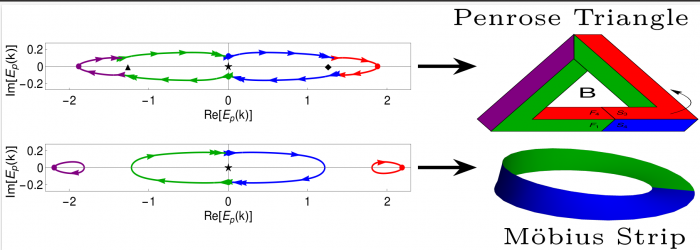Möbius strips and Penrose triangles realised in complex band structures of one-dimensional dissipative lattices
[Posted on 20 August 2022]

Scientists have discovered novel phases with intriguing topological properties in one-dimensional non-conservative systems which can have potential applications in engineering topological matter for better metrology and sensing (e.g., topological laser robust against imperfections).
Topology is a geometric property of an object that remains invariant under continuous deformations, such as stretching, twisting, and bending. Popular geometric objects with interesting topological properties are Möbius strips and Penrose triangles (see the picture). Topological study has enormously succeeded in isolated quantum systems with conserved energy. The presence of dissipation, e.g., friction, viscous drag, resistance, and pumping of energy or particles to a system, makes it non-conservative or dissipative. Standard lasers and metallic electrons inside lattice vibrations are examples of non-conservative systems that are in abundance in nature. Therefore, an extension of the concepts of topology in conservative systems to their non-conservative counterparts is natural and vital.
The energy levels of an isolated quantum system are real numbers, and those of a quantum system in contact with an environment become complex numbers due to the exchange of energy between the system and environment. The complex-valued energy levels of dissipative lattices generate intriguing composite metallic and insulating phases with no analog in the conservative systems. These exotic phases have the topology of well-known geometric objects like the Möbius strip and Penrose triangle.
Previous works have primarily focused on topological properties, such as topological phases and invariants to characterize those phases of dissipative lattices with each unit cell containing two sites/atoms.
A new research by scientists of Raman Research Institute, an autonomous institute of Department of Science and Technology provides a general framework to quantify the topology of phases in one-dimensional dissipative lattices, with each unit cell containing any number of sites/atoms. The researchers Ritu Nehra and Dibyendu Roy used a parametric space of real and imaginary parts of complex energies to characterize the topology of those complex energy levels of the quantum system in contact with an environment. In the research published in Physical Review they have discovered dissipative materials whose complex energies show the topology of Möbius strips and Penrose triangles (see the picture).
For more details please visit: https://arxiv.org/abs/2201.12297